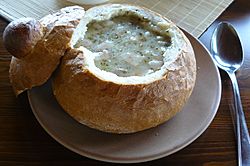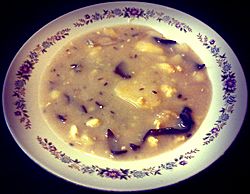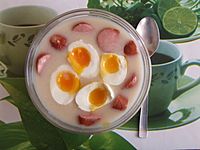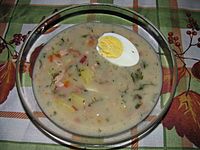West Slavic fermented cereal soups facts for kids
Fermented cereal soups are a special kind of soup popular in countries like Poland, Belarus, Slovakia, and the Czech Republic. These soups are made using grains like rye, wheat, or oatmeal that have been fermented. This means they are left to sit for a while, allowing good bacteria to grow, which gives the soup a unique sour taste.
In Poland, a famous fermented rye soup is called żur. Another version, made with wheat flour, is known as barszcz biały (which means "white borscht"). In the Czech Republic, a similar sour soup is called kyselo. These soups are often hearty and filling, perfect for cold weather or special occasions.
Contents
Poland's Żur Soup

Żur in a bowl made of bread
|
|
| Alternative names | Żurek, Sauermehlsuppe |
|---|---|
| Course | Soup, Entree |
| Place of origin | Poland |
| Serving temperature | Hot |
| Main ingredients | Soured rye flour; sausage, bacon, or ham |
| Variations | Barszcz biały, kisełycia |
Żur (pronounced "zhoor") is a traditional Polish soup. It's made from soured rye flour, which is similar to the starter used for sourdough bread. This gives the soup its special tangy flavor. People often add meat to it, like boiled pork sausage, smoked sausage, bacon, or ham.
The way żur is made can be a little different depending on where you are in Poland. Sometimes, it's served in a cool edible bowl made from bread! Other times, it comes with boiled potatoes. In the Silesia region, a type called żur śląski is served over mashed potatoes. If you're in the Podlaskie area, you might find żurek served with hard-boiled eggs cut in half. In the Polish Subcarpathia, there's even a version made from fermented oatmeal called żur owsiany.
Żurek is a very popular soup, especially around Easter time in Poland. But people enjoy it throughout the year too. It's often flavored with bits of sausage and eaten with fresh bread or buns.
-
Żur with kiełbasa and halved boiled eggs
Belarus's Zhur Soup
In Belarus, a soup similar to żur is called zhur (pronounced "zhoor") or kisyalitsa. This soup is also made from fermented oatmeal or rye. Sometimes, the word zhur can also mean a thicker porridge or a type of jelly-like dish made from fermented oatmeal. This kind of dish has been known in the region since ancient times, going back to the Kievan Rus' era.
Czech Republic's Kyselo Soup
 |
|
| Alternative names | Krkonošské kyselo, Kübelsauer |
|---|---|
| Course | Soup, Entrée, Main course |
| Place of origin | Czech Republic |
| Region or state | Krkonoše |
| Serving temperature | Hot |
| Main ingredients | Sourdough, mushrooms, caraway |
| 250 (depends on ingredients) kcal | |
Kyselo (pronounced "kih-seh-loh") is a traditional Czech soup. It's made from sourdough and mushrooms. This hearty soup comes from the poor mountain regions of Northern Bohemia, especially the Krkonoše mountains. It's known for being very filling and healthy, packed with proteins, B vitamins, and dietary fiber.
Kyselo's History
For hundreds of years, kyselo was a daily meal for people living in the Krkonoše mountains, especially in winter. It was made from ingredients that were easy to find, cheap, and could be stored for a long time, like dried mushrooms. This made it a great source of energy for people doing hard work in the mountains.
Historically, kyselo was made without eggs because eggs were usually sold, not eaten by the family. Potatoes also became common in Czech lands later, so older versions of the soup didn't have them. The use of sourdough shows that kyselo has very old roots, possibly going back to medieval times when people made fermented grain porridges. Since the Krkonoše region is on the border with Poland, kyselo is quite similar to the Polish sour rye soup.
What Kyselo Means
The word kyselo comes from the Czech word kyselý, which means 'sour'. The sourdough used to make the soup is called "chlebový kvásek" or "chlebový kvas".
Sometimes, another Czech mushroom soup called kulajda is mistakenly called kyselo. But kulajda uses sour cream or milk and vinegar, not sourdough. To avoid confusion, kyselo is often called Krkonošské kyselo, meaning "Kyselo from Krkonoše."
Ingredients and How It's Made
The main part of kyselo is a strong broth made from mushrooms and caraway seeds cooked in water. People usually use common European mushrooms like cep, and they often use dried mushrooms in winter. The broth is then made thicker with sourdough, ideally made from rye flour. Many families in Krkonoše used to keep their own sourdough starter for years in special pots.
To finish the soup, onions are cooked in butter and added. Boiled and roasted potatoes are also mixed in, along with scrambled eggs. The soup is seasoned with salt and vinegar. Because it's such an old dish, there isn't one single recipe for kyselo. Each family might make it a little differently, passing down their recipe by talking about it. Some versions might not have eggs, or they might use hard-boiled eggs instead of scrambled, or even include cream.
Today, you can even buy instant kyselo powder for quick preparation.
Some ingredients that might be used in kyselo include:
- cured bones
- pork ribs
- weisswurst
- pork belly
- onion
- potatoes
- carrots
- celery
- parsley
- marjoram
- bay leaves
- allspice
- lovage
- caraway
- garlic
- mushrooms
- cream
- horseradish
- eggs (to serve)
- rye wholemeal bread croutons
How Kyselo Is Served
Kyselo is always served hot in a soup plate or bowl. Some restaurants even serve it in an edible bread bowl, just like żur. It might be decorated with chopped scallion, parsley, or other green herbs. People eat it with a spoon. Sometimes, the potatoes are served separately on a plate, so everyone can add as much as they like. Salt and vinegar are often on the table too, so people can adjust the taste to their liking.
Because kyselo is so filling, it's often eaten as the main meal. But in smaller amounts, it can also be served as a starter.
Kyselo in Stories
As a very important food, kyselo appears in local legends and fairy tales, especially those about the mythical mountain lord Krakonoš. People say that Krakonoš gave sourdough to humans and invented kyselo. There's even a mountain in Krkonoše called Kotel, which means 'cauldron'. When fog rises from the valley below Kotel, people say Krakonoš is cooking kyselo!
The name kyselo is also well-known across the Czech Republic because of a popular children's television series called Krkonošské pohádky (Fairy Tales from Krkonoše). In almost every episode, one of the main characters, Anče, cooks kyselo.
Similar Soups Around the World
Many other cultures have soups made from soured flour or other fermented ingredients. For example:
- In Russia, there's okroshka, which is made with kvass (a fermented drink).
- Romanian borș is made from fermented wheat or barley bran.
- Finnish hapanvelli soup uses peas and sourdough.
- A more distant relative is Japanese miso soup, which uses miso paste, a fermented soybean paste.
See also
 In Spanish: Żurek para niños
In Spanish: Żurek para niños



